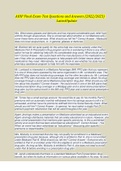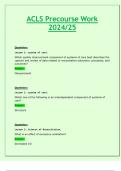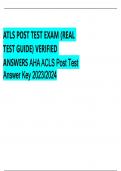acls (ACLS)
Chamberlain College Of Nursing
Popular textbooks
Advanced Cardiovascular Life Support
1 documents
All 117 results
Sort by
different nursing courses exams bundled together
ACLS Precourse Work - Lesson 1 to Lesson 13
![ALS/ACLS - Red Cross Final Exam [2024]](/docpics/6115929/66d5f04464c41_6115929_121_171.jpeg)
-
ALS/ACLS - Red Cross Final Exam [2024]
- Exam (elaborations) • 10 pages • 2024
-
- $12.00
- + learn more
The resuscitation team suspects that hyperkalemia is the cause of cardiac arrest in a patient brought to the emergency department. Which finding on a 12-lead ECG would confirm this suspicion? - Wide-complex ventricular rhythm or tall, pointed T waves A patient with dyspnea and a change in mental status arrives at the emergency department. The healthcare team completes the necessary assessments and begins to care for the patient, including initiating cardiac monitoring, pulse oximetry, suppleme...
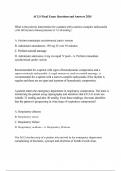
-
ACLS Final Exam Questions and Answers 2024
- Exam (elaborations) • 19 pages • 2024
-
- $12.00
- + learn more
What is the priority intervention for a patient with a narrow-complex tachycardia (160 BPM) and a blood pressure of 72/48 mmHg? A. Perform immediate synchronized cardio version B. Administer amiodarone, 150 mg IV over 10 minutes C. Perform carotid massage D. Administer adenosine, 6 mg via rapid IV push - A. Perform immediate synchronized cardio version Recommended for a aptient with signs of hemodynamic compromise and a superventricualr tachycardia. A vagal maneuver, such as carotid massage...

-
ACLS Final Exam Questions and Answers 2024
- Exam (elaborations) • 19 pages • 2024
-
Available in package deal
-
- $10.00
- + learn more
What is the priority intervention for a patient with a narrow-complex tachycardia (160 BPM) and a blood pressure of 72/48 mmHg? A. Perform immediate synchronized cardio version B. Administer amiodarone, 150 mg IV over 10 minutes C. Perform carotid massage D. Administer adenosine, 6 mg via rapid IV push - A. Perform immediate synchronized cardio version Recommended for a aptient with signs of hemodynamic compromise and a superventricualr tachycardia. A vagal maneuver, such as carotid mass...
![ALS/ACLS - Red Cross Final Exam [2024]](/docpics/5486345/66586649cad6f_5486345_121_171.jpeg)
-
ALS/ACLS - Red Cross Final Exam [2024]
- Exam (elaborations) • 10 pages • 2024
-
- $10.00
- + learn more
The resuscitation team suspects that hyperkalemia is the cause of cardiac arrest in a patient brought to the emergency department. Which finding on a 12-lead ECG would confirm this suspicion? - Wide-complex ventricular rhythm or tall, pointed T waves A patient with dyspnea and a change in mental status arrives at the emergency department. The healthcare team completes the necessary assessments and begins to care for the patient, including initiating cardiac monitoring, pulse oximetry, sup...

-
ACLS practice questions
- Exam (elaborations) • 16 pages • 2024
-
Available in package deal
-
- $10.99
- + learn more
ACLS practice questions What element of a system of care is represented by properly functioning resuscitation equipment? System Structure Process Patient outcome - ANS Structure What is the first link in the out-of-hospital cardiac arrest (OHCA) chain of survival? Activation of emergency response Defibrillation Advanced resuscitation High-quality CPR - ANS Activation of emergency reponse What are signs of clinical deterioration that would prompt the activation of ...
BEST ATLS ACLS EXAM BUNLDE 2024/2025 WITH 100% VERIFIED ANSWERS GUARANTEEED PASSS BEST ATLS ACLS EXAM BUNLDE 2024/2025 WITH 100% VERIFIED ANSWERS GUARANTEEED PASSS
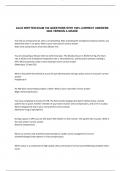
-
ACLS WRITTEN EXAM 100 QUESTIONS WITH 100% CORRECT ANSWERS 2024 VERSION A GRADE
- Exam (elaborations) • 17 pages • 2024
-
- $10.00
- + learn more
You find an unresponsive pt. who is not breathing. After activating the emergency response system, you determine there is no pulse. What is your next action? correct answer Start chest compressions of at least 100 per min. You are evaluating a 58-year-old man with chest pain. The blood pressure is 92/50 mm Hg, the heart rate is 92/min, the nonlabored respiratory rate is 14 breaths/min, and the pulse oximetry reading is 97%. What assessment step is most important now? correct answer Obtain...
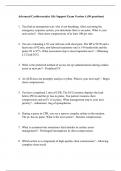
-
Advanced Cardiovascular Life Support Exam Version A (50 questions)
- Exam (elaborations) • 7 pages • 2024
-
- $10.00
- + learn more
1. You find an unresponsive pt. who is not breathing. After activating the emergency response system, you determine there is no pulse. What is your next action? - Start chest compressions of at least 100 per min. 2. You are evaluating a 58 year old man with chest pain. The BP is 92/50 and a heart rate of 92/min, non-labored respiratory rate is 14 breaths/min and the pulse O2 is 97%. What assessment step is most important now? - Obtaining a 12 lead ECG. 3. What is the preferred method of ac...
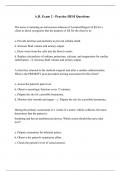
-
A.H. Exam 2 - Practice HESI Questions
- Exam (elaborations) • 25 pages • 2024
-
- $10.00
- + learn more
The nurse is initiating an intravenous infusion of Lactated Ringer's (LR) for a client in shock recognizes that the purpose of LR for the client is to: a. Provide dextrose and nutrients to prevent cellular death. b. Increase fluid volume and urinary output. c. Draw water from the cells into the blood vessels. d. Replace electrolytes of sodium, potassium, calcium, and magnesium for cardiac stabilization. - b. Increase fluid volume and urinary output. A client has returned to the medical-s...

Did you know that on average a seller on Stuvia earns $82 per month selling study resources? Hmm, hint, hint. Discover all about earning on Stuvia

